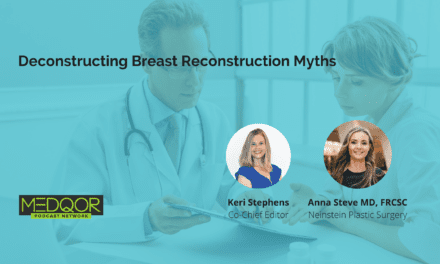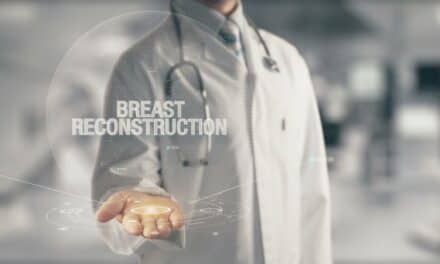By: Constance M. Chen, MD, MPH, FACS
Autologous tissue breast reconstruction creates soft, warm, and living breasts from a woman’s own body tissue, and many consider it to be the gold standard in breast reconstruction. Despite this, many thin women report that they have been told that their only option for breast reconstruction is implants because they do not have enough fat to undergo natural tissue breast reconstruction.
Why are thin women being turned away? Even among specialists, many plastic surgeons are primarily familiar with the abdomen as a donor site for breast reconstruction—and many thin women have minimal abdominal fat. Breast reconstruction using abdominal flaps, such as the TRAM or DIEP flaps, transfer fat, skin, and blood vessels—and in the case of the TRAM flap, the rectus abdominis muscle, too—transfers tissue from the lower abdomen to the chest to build the new breast, and they are the most common options for autologous tissue breast reconstruction.
The abdomen is not the only donor site for breast reconstruction, however. Innovative advances in breast reconstruction allow highly specialized microsurgeons to expand the possible donor sites for breast reconstruction. This shift accomplishes two major goals: Very skilled surgeons can think outside the box to look to other areas of the body for natural tissue breast reconstruction. In turn, thin women can more fully benefit from procedures that work with their body shape to reconstruct new breasts from their own tissue.
Additional Options for Natural Tissue Breast Reconstruction
What types of natural tissue breast reconstruction work well for thin people?
PAP: Profunda artery perforator, or PAP, flap surgery harvests the skin and fat of the upper inner thigh, where almost all women can pinch excess tissue even if their abdomen has minimal fat and skin. The skin and fat of the upper inner thigh is also very soft and pliable, and it can be shaped nicely to create a very youthful and perky breast. As with all perforator flaps, no muscle is sacrificed to leave patients with lasting weakness. The donor site scar is concealed in the groin crease so that it can be difficult to see in the mirror.
TDAP: Thoracodorsal artery perforator (TDAP) flap surgery harvests the skin and fat of the upper back. Like all perforator flaps, the latissimus dorsi muscle is left intact so that there are no problems with swimming or climbing ladders. This is a pedicled flap, meaning that the tissue stays connected to the blood vessels so that microsurgery is not needed. The donor site scar can be designed to be hidden in the bra line.
Stacked DIEP: Combining two abdominal flaps from both sides of the abdomen and layering them to create one breast provides sufficient volume to form a single breast when a single flap from one side would be insufficient. The stacked deep inferior epigastric perforator (DIEP) can only be used to reconstruct one breast.
DIEP/DCIA: Combining a larger area of the lower abdomen extending around the sides, the extended DIEP/DCIA flap allows even thin women to use their lower abdominal donor site for breast reconstruction. Technically, two flaps on each side are used based on the blood supply from both the DIEP and the deep circumflex iliac artery (DCIA) perforator. Thus, the extended DIEP/DCIA flap allows more tissue to be used from the lower torso so that there is adequate volume to form two separate breasts.
GAP: Gluteal artery perforator (GAP) flap surgery takes tissue from either the upper or lower buttock while leaving the gluteal muscle intact. The superior gluteal artery perforator (SGAP) flap removes fat from the upper buttock while the inferior gluteal artery perforator (IGAP) flap removes fat from the lower buttock. The scar from the SGAP is more visible since it is in the upper buttock while the scar from the IGAP is concealed in the buttock crease. Despite this, the SGAP is preferred because removing fat from the lower buttock in the IGAP can expose the sciatic nerve and cause discomfort when sitting and bearing weight since the cushioning tissue of the lower buttock is gone. Both GAP flaps are also longer operations since the patient needs to be turned over on the operating table, prepped, and redraped to go from the supine to the prone position and then back to the supine position during surgery.
Fat grafting: For women who would like natural tissue breast reconstruction while avoiding the large scars of flap surgery, fat grafting is an option. Fat grafting involves liposuction from one part of the body, processing the lipoaspirate to remove impurities, and injecting the purified fat cells into the chest wall to create a new breast.
Since the transferred fat graft does not come with its own blood supply and depends on the osmosis of nutrients through the cell wall to survive, however, approximately 30%-70% of the transferred fat will be resorbed and excreted by the body. Thus, when fat grafting is used to build a new breast after mastectomy, it usually requires multiple sessions over time to layer the fat to reach an adequate volume. Fat grafting can also be used to enhance the volume or contours of the breast mound from a flap if a woman feels her initial reconstruction is too small, asymmetric, or lacks fullness in the superior pole.
Inside Natural Tissue Breast Reconstruction
While the abdomen is the most common donor site for natural tissue breast reconstruction, there are other options even if you have very little abdominal tissue. Patients can undergo flap surgery from another donor site, or they can undergo fat grafting to build up a breast mound over time. The bottom line is that even very thin women are not limited if they want to undergo breast reconstruction without implants.
Further, surgeons who perform non-traditional flap procedures require highly specialized surgical training as well as expertise in microsurgery. Since many of these procedures are not common, most patients need to do research and they often need to travel to find a surgeon capable of performing these procedures. For many women after mastectomy, restoring their bodies by creating living breasts without implants is worthwhile. The journey begins when they learn that what they once thought was impossible may actually be feasible.
Constance Chen, MD, MPH, FACS, is a board-certified plastic surgeon with special expertise in the use of innovative natural techniques to optimize medical and cosmetic outcomes for women undergoing or who have undergone breast reconstruction. She operates at Lenox Hill Hospital in Manhattan’s Upper East Side and is a clinical assistant professor of surgery (plastic surgery) at Weill Cornell Medical College and Clinical Assistant Professor of Surgery (Plastic Surgery) at Tulane University School of Medicine.





